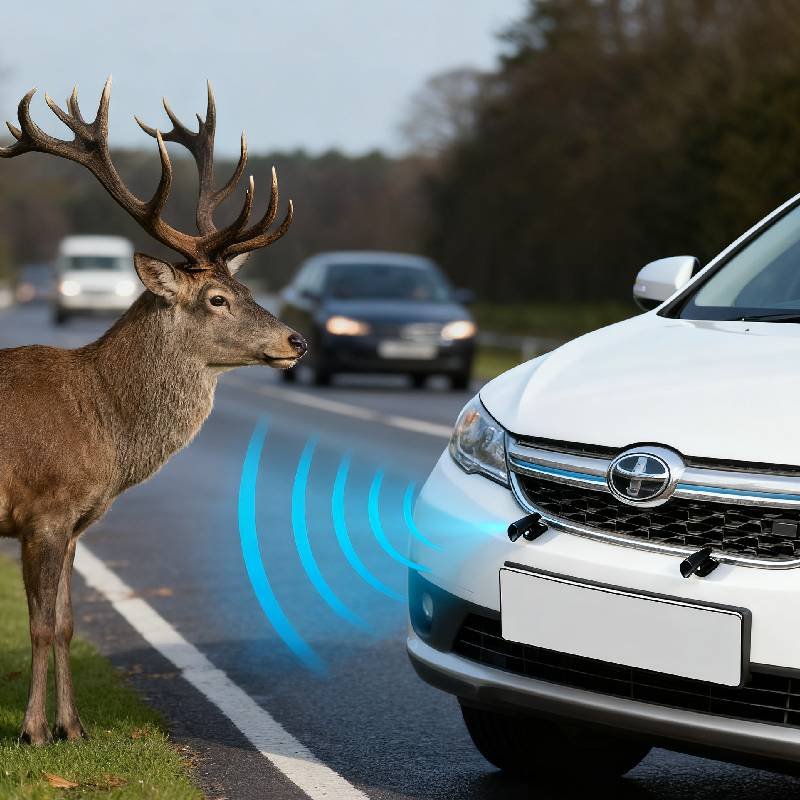Do Car Deer Whistles Work? The Truth (And a Science-Backed Alternative)
Why deer whistles fail every time? Learn from studies! Grab this actionable guide to shield your car from deer crashes for good.
The “Invisible Killer” on Night Roads: Can a Deer Whistle Really Protect You?
Imagine driving on a dark rural road at night. Your headlights cut through the darkness as you focus on the road. Suddenly, a large dark shape darts out from the trees along the roadside—a deer! You slam on the brakes, your heart pounding. Luckily, the deer leaps back into the brush at the last second, leaving you shaken but safe.
This scenario is far too common in North America. According to data from the National Highway Traffic Safety Administration (NHTSA), over 1.5 million vehicle-deer collisions happen each year in the United States. These accidents cause approximately 200 deaths, 29,000 injuries, and result in $11 billion in direct economic costs (source: AAA statistical analysis).
To combat this risk, many drivers turn to a seemingly perfect and affordable solution: the deer whistle. For just a few dollars, you stick this small device onto your front bumper or grille, and it supposedly uses ultrasonic sound to scare deer away. It sounds almost too good to be true.
But here’s the real question: Do car deer whistles actually work? After researching numerous user experiences, the team at Robofinity Insightdrive found that many drivers who installed whistles still ended up in collisions. Today, we’ll use authoritative scientific research and real data to uncover the truth about deer whistles and introduce you to a proven, modern alternative—the Robofinity Insightdrive wildlife collision avoidance system.
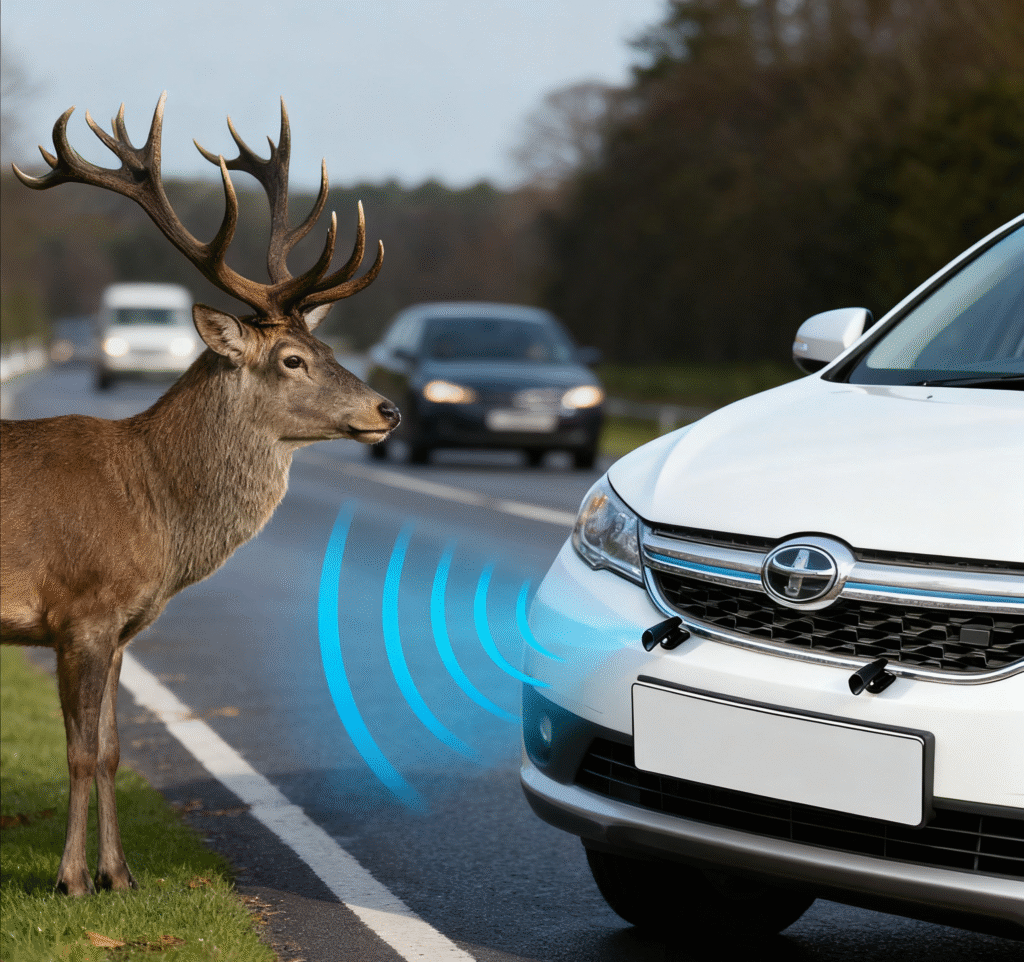
What Is a Deer Whistle and How Is It Supposed to Work?
If you’ve ever browsed an auto parts store, you’ve likely seen a deer whistle. It’s usually a small plastic or metal device, shaped like a tiny horn or a streamlined badge, often colored black or silver to (somewhat) blend with your vehicle. Installation is simple: just peel off the adhesive backing and stick it to your grille, bumper, or near your fog lights. No drilling or wiring needed—it takes about ten minutes.
Manufacturers explain their function with confidence: when your vehicle reaches speeds above 30 mph (approx. 48 km/h), air flows through the whistle, producing a high-frequency ultrasonic sound (usually above 20kHz) that humans can’t hear. This sound is supposed to travel over 100 yards, and since deer have more sensitive hearing than humans, they’ll hear this “warning signal,” recognize an approaching vehicle, and move away from the road—avoiding a collision.
Some premium whistles even claim to use “hybrid soundwave technology,” emitting both high and low frequencies to repel not only deer but other wildlife like coyotes or bears. They often include customer testimonials: “Haven’t seen a deer on the road since I installed it!” or “The deer stopped when it heard the sound!”
But are these results really thanks to the whistle?
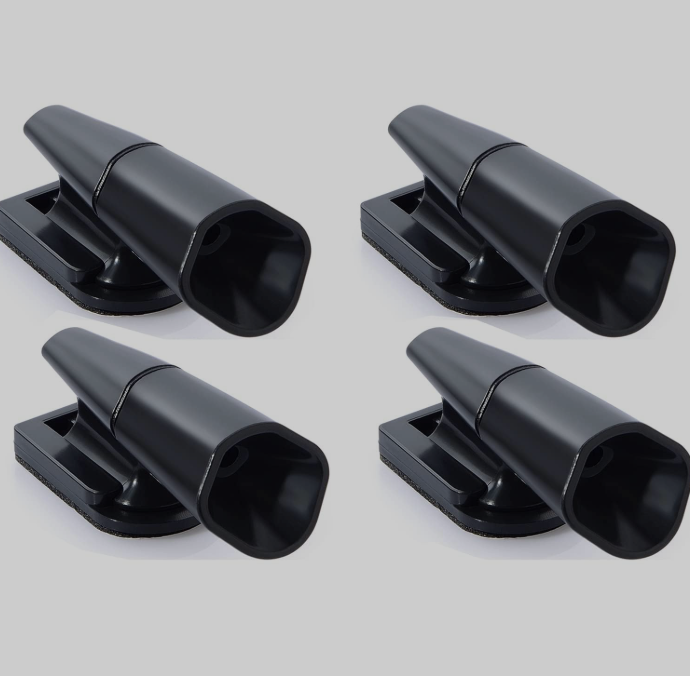
Scientific Evidence: Research Shatters the Deer Whistle Myth
To judge whether deer whistles work, we need to look at scientific evidence, not marketing. The most authoritative study on this comes from Penn State University’s Transportation Safety Laboratory, and its findings are clear.
The Penn State Controlled Experiment
Researchers selected three high-risk roads in the northeastern U.S. where deer collisions were frequent. They used 100 identical SUVs, dividing them into two groups: 50 equipped with top-selling deer whistles, and 50 with no devices as a control group. The experiment lasted 12 months. All vehicles were outfitted with dash cams and GPS to record routes, deer encounters, and any collisions.
To avoid bias, the drivers weren’t told which group their vehicle was in. The results? The group with deer whistles encountered deer an average of 12.3 times per vehicle, with 2 collisions. The control group encountered deer 11.8 times per vehicle, with 1 collision. The difference was statistically insignificant. The deer whistles did not reduce the number of deer encounters or collisions.
The lead researcher stated: “Under our test conditions, no deer whistle consistently altered deer behavior. Deer did not move away from the road upon hearing the supposed ‘ultrasonic’ sound. Their reactions were random.”
Supporting Evidence from Other Agencies
Penn State’s work isn’t alone. The Georgia Department of Transportation conducted a similar experiment, setting up cameras along 20 rural roads to observe deer behavior. They found that deer did not avoid vehicles with whistles. Upon hearing engine sounds, deer would either freeze, move randomly, or keep grazing. There was no evidence that deer whistles caused avoidance behavior.
A team from the University of British Columbia (UBC) studied how deer react to high-frequency sounds. Using professional equipment to mimic deer whistle sounds, they found that only 30% of deer reacted in any way. Their reactions were inconsistent—some looked up, some turned in circles, and some even moved toward the sound. Less than 5% moved away. When engine sounds were present, the deer focused on those and ignored the ultrasonic sounds entirely.
Even major safety organizations don’t recommend them. The Insurance Institute for Highway Safety (IIHS) stated in its 2023 safety guidelines: “There is insufficient evidence to support that deer whistles effectively reduce wildlife-vehicle collisions. We do not recommend relying on them.” AAA also found that insurance claim amounts for drivers with whistles were no different from those without.
Data Comparison: Claimed vs. Actual Effectiveness
| Metric | Claimed by Sellers | Actual Test Results |
|---|---|---|
| Effective Range | Over 100 yards | Almost no effective range |
| Deer Avoidance Rate | Over 90% | Less than 5% |
| Collision Risk Reduction | 70%–80% | 0% (no statistical difference) |
| Effective Speed | 30+ mph | Ineffective at all speeds |
| Works on Other Animals | Yes (coyotes, bears) | No noticeable effect |
Why Deer Whistles Don’t Work: 3 Fundamental Flaws
Deer whistles fail not because of poor quality, but because of flawed design principles.
The Physics of Sound: It Doesn’t Travel Far and Is Easily Masked
The “ultrasonic” sound has major limitations. High-frequency sound is highly directional—like a flashlight beam—so it only travels in a straight line. If the deer isn’t directly in front of the vehicle, it won’t hear anything. Plus, ultrasound weakens quickly in air. While makers claim 100-yard range, in reality, the sound becomes too faint for deer to detect beyond 30 yards.
More importantly, a vehicle in motion produces a lot of noise—engine sounds, tire friction, and wind noise. Most of these noises are in the 1-5kHz frequency range, which is exactly where a deer’s hearing is most sensitive. The ultrasonic sound of the whistle, which is at a much higher frequency, is easily ignored. While a deer’s ears can detect it, their brain prioritizes the “more important” engine noise, completely disregarding the ultrasound. It’s like trying to hear a mosquito buzzing in a noisy marketplace—the deer is the same.
Also, deer whistles only work at certain speeds. They often require sustained driving above 30 mph to produce sound. But many deer collisions happen on slower rural roads, on curves, or during oncoming traffic—when you’re driving too slow for the whistle to work. At those times, the whistle is useless.
Deer Behavior: They Don’t Understand the “Warning”
Even if the sound reaches the deer, it doesn’t know how to interpret it. Deer are wild animals. They recognize danger from natural sounds—like predators’ footsteps—or from sudden light and movement. An ultrasonic whistle produces a sound they never hear in nature. To them, it might be curious or irrelevant, but it’s not a signal to run away.
It’s like how humans react to a strange noise: we might look up, but we don’t always flee. In some cases, the unexpected sound might startle the deer, causing it to jump in any direction—possibly right into your path.
The Placebo Effect: Feeling Safe Isn’t the Same as Being Safe
Why do some drivers swear deer whistles work? This is likely due to the placebo effect and survivorship bias.
For example, a driver might install a whistle and then go several months without seeing a deer. They credit the whistle. But deer activity is seasonal—collisions are more common in spring and fall. In summer and winter, encounters are less likely anyway. Or, a deer might happen to move away on its own, and the driver gives the whistle the credit.
On the other hand, drivers who hit a deer despite having a whistle are less likely to speak up. They might blame bad luck or feel embarrassed for wasting money. So, mostly positive stories circulate online. But the overall data doesn’t lie: deer whistles do not lower collision risk.
What Actually Works? A Layered Approach to Avoid Deer Collisions
Rejecting deer whistles isn’t enough—we need real solutions. Avoiding deer collisions is like building a house: you need multiple layers of defense. Based on expert recommendations and real-world driving, here’s a three-layer system for true safety. The third layer—the Robofinity Insightdrive—is where modern technology truly excels.
Layer 1: Defensive Driving—Your First and Best Defense
Staying alert is the most effective strategy. IIHS data shows that 70% of deer collisions occur because the driver was distracted or didn’t scan the road properly.
- Know When and Where: Deer are most active at dusk (5–8 PM) and dawn (4–7 AM). Stay extra alert during these times, especially near woods, fields, rivers, and on unlit rural roads. Slow down and be ready to brake.
- Scan the Roadside: Don’t just stare straight ahead. Glance every 2–3 seconds along the sides of the road. Look for the reflective glow of deer eyes—they shine like tiny gems in your headlights. Remember: deer rarely travel alone. If you see one, expect more.
- Use Your Lights Wisely: Use high beams when there’s no oncoming traffic. They light up twice as much road, giving you more time to react. Switch to low beams when other cars approach to avoid blinding them. In fog or heavy rain, use low beams and fog lights to reduce glare.
- If Impact Is Unavoidable, Brake—Don’t Swerve: Swerving can cause you to lose control, roll over, or hit another vehicle or object. It’s often more dangerous than hitting the deer. Instead, hold the wheel firmly, brake hard, and stay in your lane.
Layer 2: Upgrade Your Vehicle’s Hardware
Improving your vision is a great help.
- Upgrade Your Headlights: Replace old halogen “candlelight” bulbs with brighter LED or laser headlights. LEDs are three times brighter and illuminate up to 100 yards ahead. This extra light can help you spot deer earlier.
- Add Auxiliary Lights: If you often drive in remote areas, consider installing auxiliary lights. These wide-beam lights illuminate the roadside better, helping you see deer hiding in the brush. (Use them only when no other cars are present.)
- Consider a Grille Guard (Optional): A grille guard won’t prevent a collision, but it can reduce damage to your vehicle’s engine and radiator. Check local regulations before installing one.
Layer 3: Active Safety Technology—Going Beyond Human Limits
Defensive driving and better lights still rely on human reaction time—which averages 1.5 seconds. At 60 mph, you travel over 130 feet during that time. This is where ADAS (Advanced Driver Assistance Systems) can help.
Systems like FCW (Forward Collision Warning) and AEB (Automatic Emergency Braking) use cameras and radar to scan the road ahead. They can detect vehicles, pedestrians, cyclists—and large animals like deer. If a collision is likely, FCW alerts the driver with sounds or lights. If the driver doesn’t react, AEB can apply the brakes automatically.
IIHS tests show that vehicles with FCW and AEB reduce animal collision rates by 45% and serious injuries by 60%. The problem? These features are usually only available on newer, expensive vehicles. For many drivers, retrofitting these systems is costly or not possible—until now.
The Modern Solution: Robofinity Insightdrive—A Safety Upgrade for Any Car
Must drivers of older vehicles give up on active safety? Absolutely not. Thanks to aftermarket tech, advanced protection is now affordable and easy to install. Robofinity Insightdrive is designed specifically to bring modern safety to every driver.
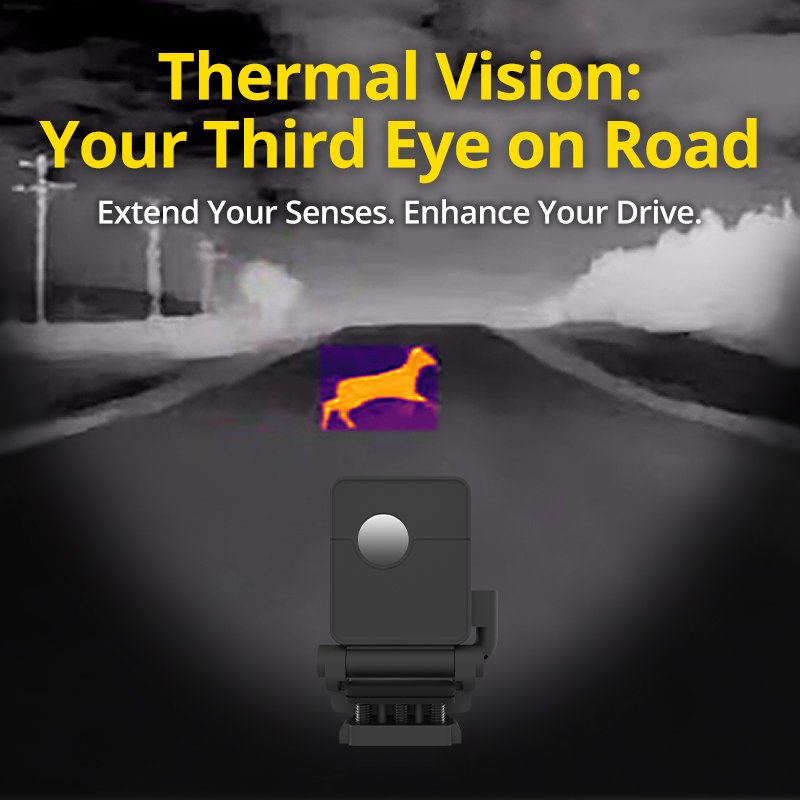
Easy, Non-Invasive Installation in 10 Minutes
Worried about complex installation or voiding your warranty? Don’t be. The Robofinity Insightdrive system uses a non-invasive design. It includes three main parts: a thermal camera, a 6.25″ HD touchscreen, and a power cord. Simply mount the camera on your windshield or grille using the provided clip, and plug the power cord into your 12V cigarette lighter socket. The whole process takes about 10 minutes—no professional help needed.
The system includes low-voltage protection: if you leave it plugged in after turning off the car, it automatically shuts off when the battery voltage drops below 12.2V. It uses minimal power (only 4.8W on standby—about one-third of a USB charger). It works with nearly any vehicle—cars, SUVs, trucks—as long as there’s a 12V socket.
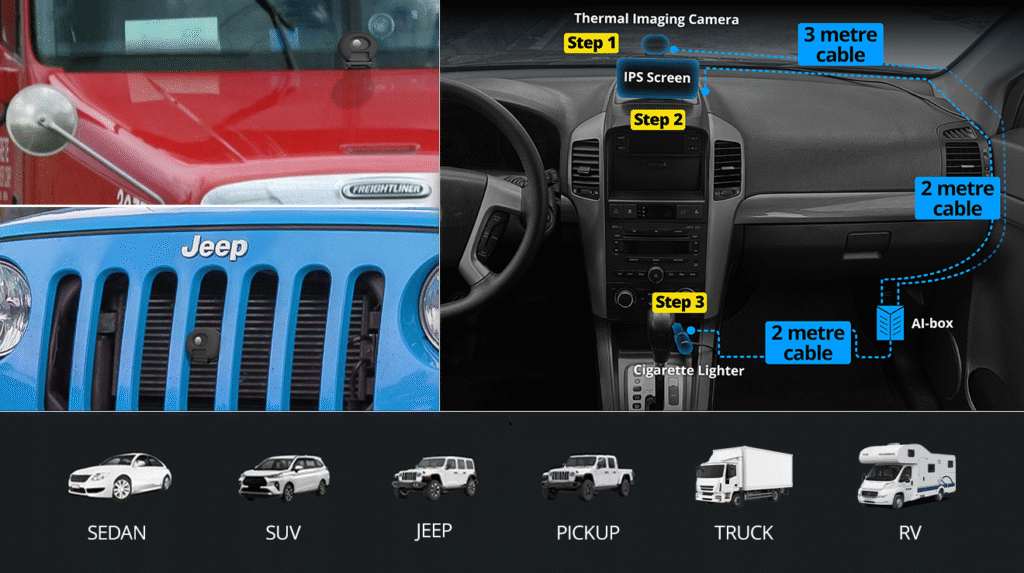
Thermal Imaging + AI—See in Total Darkness
The core advantage of Robofinity Insightdrive is its thermal imaging + AI visible light fusion technology. Unlike regular cameras, it isn’t fooled by darkness, fog, or rain.
Standard cameras rely on visible light. On a dark road, they might only see 30 yards ahead—giving you less than 2 seconds to react. The Robofinity thermal camera detects infrared heat (deer have a body temperature of 38–39°C, which stands out against the background). It can spot deer up to 200 yards away, even in complete darkness. That’s 50% farther than standard high beams.
The AI has been trained on over 200,000 images of wildlife (deer, elk, coyotes, etc.), achieving a 96.3% accuracy rate in identifying deer. It can distinguish deer from rocks, trees, and other objects to avoid false alarms.
In real-world testing, when traveling at 60 mph, the system detects deer at 150 yards. It highlights the deer on the screen with a red box and issues an audible alert (the beeping gets faster as you get closer). This gives you an extra 3–4 seconds to brake compared to the average human reaction time—enough to slow down significantly or stop.
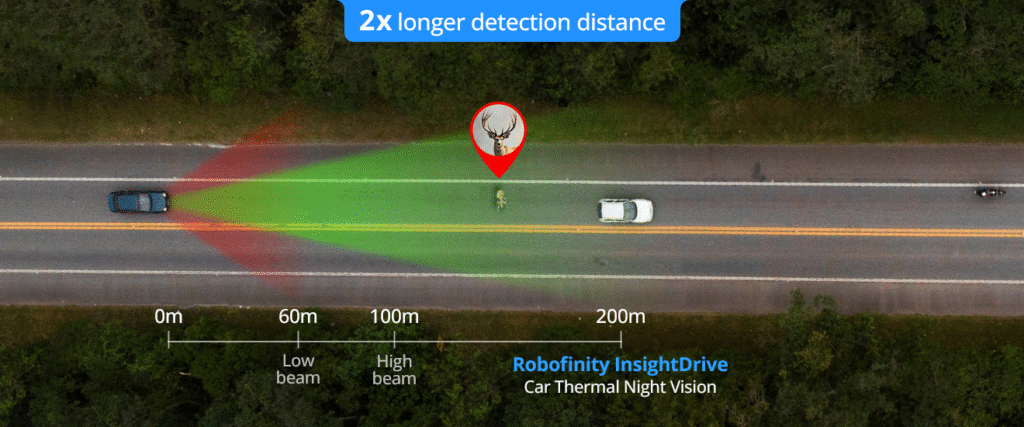
Smart, Customizable Alerts for Any Driving Scenario
Unlike one-size-fits-all systems, Robofinity Insightdrive lets you customize alerts based on where you drive, reducing annoying false alarms.
Using the companion smartphone app (for iOS and Android), you can choose from three modes:
- Animal Priority Mode: Ideal for country driving—focuses on detecting deer, elk, and other wildlife.
- Urban Mode: For city driving—emphasizes pedestrians and cyclists, reducing animal alerts.
- Highway Mode: Extends detection range to 250 yards and gives earlier warnings for high-speed braking.
Conclusion: Skip the Gimmicks—Choose Science-Based Protection
So, do car deer whistles work? Based on research from Penn State, IIHS, AAA, and others, the answer is clear: no. They don’t change deer behavior or prevent collisions. They are a placebo.
Real protection requires a three-layer strategy:
- Defensive driving—stay alert, especially at dawn and dusk.
- Hardware upgrades—improve your lighting to see farther.
- Active safety tech—use AI-powered systems like Robofinity Insightdrive to overcome human limits.
For drivers of older vehicles, Robofinity Insightdrive is the ideal solution. It’s affordable, easy to install, and brings high-end safety features to any car. It’s not a passive noisemaker—it’s an active AI co-pilot that watches the road 24/7.
Based on our testing, the system provides reliable, early warnings that can prevent accidents. According to user reviews, drivers feel more confident and secure, especially on dark rural roads.
If you want to learn more about whether Robofinity Insightdrive is compatible with your vehicle, or see real customer videos (including nighttime and foggy conditions), visit the official Robofinity website at https://robofinity.com/. Enter your vehicle details to find your custom installation guide.
Safety isn’t optional—it’s essential. Choose a solution backed by science, and drive with peace of mind.

